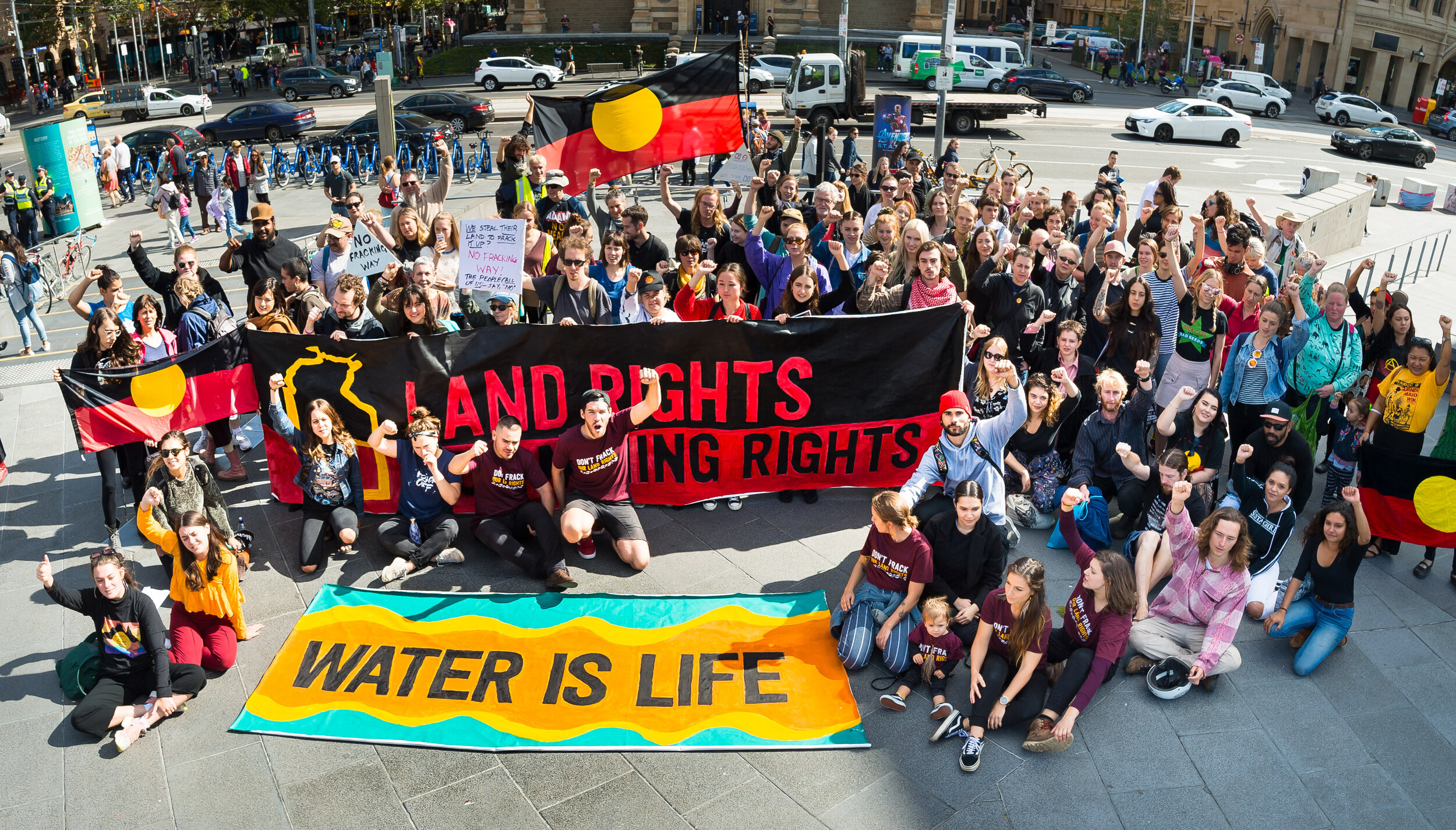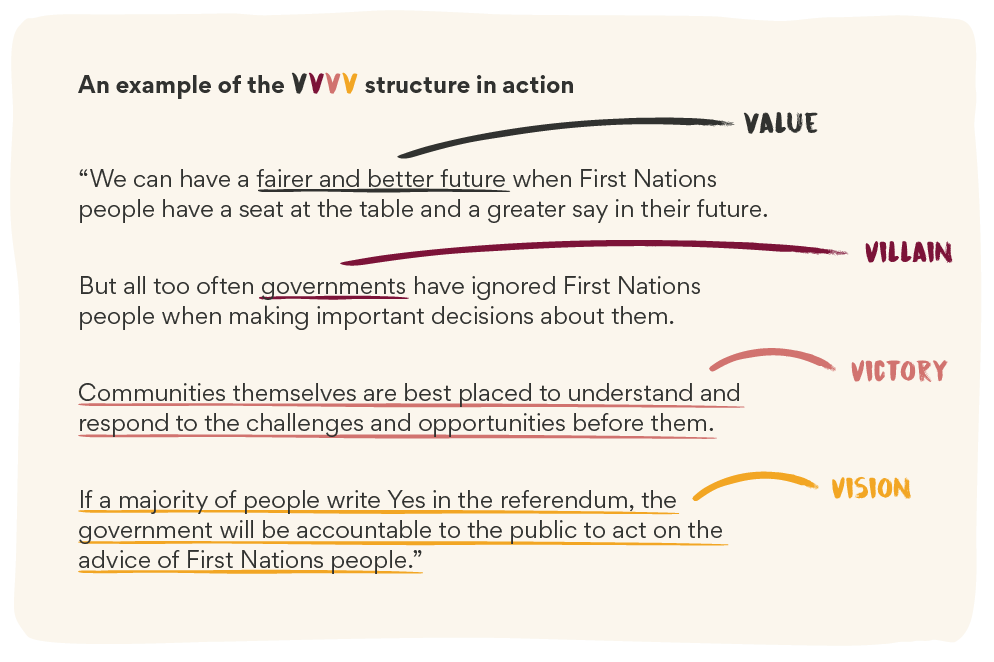
Messaging 101
Why messaging matters
When we get the right message, delivered by the right messengers, to the right audience, at the right time, we win campaigns. Over time, we also generate the sustained attitude shifts that mean the next campaign is easier to win. We build momentum for long-term change.
A great message doesn’t say what’s already popular -
a great message makes popular what needs to be said.
Anat Shenker-Osorio
Global messaging expert and advisor to Passing The Message Stick

How to change a narrative?
We change the narrative by all singing from the same song sheet – across First Nations organisations, civil society organisations, First Nations spokespeople and allies. Together we can flood conversations and social media with our aspirations for change, and in turn shape the national media narrative.
We must avoid negation and repeating the opponent’s frame - and instead be more compelling than them. We’ll know we are shifting the national narrative when we hear people repeating our messages, and when people are more comfortable about engaging in a conversation.
VVVV Proven messaging structure
Here’s a framework to shift our messages into a strength-based frame, draw attention to the institutions and people who cause us harm, share our expert solutions, and paint a picture of how we can create a better future together.
Value
Start with a shared value that hooks our audience. These are common sense statements that reasonable people agree with.
“Everyone deserves equal respect and dignity.”
“People are better off when they’re free to set their own course.”
“Taking care of one another what community is all about.”
Villain
Then describe the villain who is creating barriers for us, and name their intentions. Be as specific as possible - who is involved, what they are doing, and what’s their motive?
“The state government took away funding from our services.”
“Police are targeting Aboriginal people.”
“Mining corporations are destroying our communities for profit.”
Victory
Next, share your victory, or a clear ask and solution. Clear asks and solutions grounded in strength and capability are compelling and show we know what’s best for our communities.
“Our communities thrive when we’re in control. We need everyone to stand with us and call for full funding of our community controlled services.”
“We need to change the Heritage Act so that Aboriginal people have the right to veto projects that will destroy our heritage.”
Vision
Wrap up your message with a vision of a positive, hopeful future. This provides hope to our base and persuadables who genuinely want better lives for First Nations people.
“Together, we can make sure everyone in our community has the things they need to live well.”
“With true justice, we can live in a society where everyone is treated with respect and dignity.”
Understanding audiences
A message is like a baton - it gets passed on by people.
The goal of our research has been to find the best messages to energise our base, persuade the majority in the middle, and repel our opponents. Our methodology divided audiences into these three broad categories - the base, persuadables and opponents.
Click here to learn more about theses audiences in our methodology section.

What’s a frame, and how can we use them to win?
A frame is like a picture frame, it helps our audience focus on what we want them to think about, and excludes and obscures ideas outside it.
The choices we make about how we frame our issues completely shape people’s understanding of an idea.
For example, when you think of the word ‘restaurant’, things like food, cutlery, tables, chairs and diners fit into the ‘frame’, while things like an elephant or car don’t fit. You’d be surprised or confused if an elephant or car suddenly appeared in a restaurant, and the same applies to our messages.
When we add something that doesn’t ‘belong’ in a frame, it becomes difficult for the reader or listener to follow what’s happening – and this waters down the effectiveness of our messages.
When we craft messages, we use ‘frames’ to explain issues in a certain way. This helps our audience to understand the problems, solutions and context, and see things the way we see them (ensuring we’re on the same page, which helps to build support for our asks).
Here are three key principles to consider when framing your issue:
-
Universal values like listening, equity and respect resonate with everyone. Start messages with a value that hooks your audience and helps to establish the frame for the remainder of the message.
-
This is a simple rule: people do things. When describing a problem, we need to also say who is causing it. If we use passive voice, or describe problems without naming who causes them, people assume we’re the problem. Embrace active language and name who causes the unfair barriers we face, alongside their motive. We can then build on this by sharing our own knowledge and solutions to the problem.
-
People are motivated to support us when they can see that change is possible, and how it will make things better. Describe your vision for a better future, be clear in your demands and say what needs to change.
Avoid these common pitfalls
-
Hedging language
Hedging language is cautious and vague, and undermines our confidence. It makes us seem untrustworthy at worst, and wishy-washy at best. It’s the inclusion of unnecessary words like ‘we seek to’ or ‘we aim to’ through our messages. The good news is, hedging is easy to remove once we know what to look for, and makes our messages stronger and more concise. Remove hedging by asking yourself if every word is necessary, and if not, delete it.
-
Passive voice
Messages that are passive fail to name a villain (or agent) who is causing the problem. When we fail to point out who is causing the problem (e.g. a racist policing system, or X government minister), people assume we are the ones who cause the problem. Naming a specific person causing us harm is one of the most powerful ways to overcome passive and deficit language.
-
Negation
Negation is when we say what we’re ‘not’, and we do this all the time when we rebut opposition messages. The problem is, people don’t remember whether we say something is true or not, they just remember the association. For example, we say “our families are not dysfunctional” and people remember “families are dysfunctional”. It’s important we never negate the opposition frame, and instead speak from our power, strength, knowledge and capability.
-
Deficit narratives
Deficit language like ‘dysfunction’, ‘special treatment’ and ‘lack of capacity’ fuels the opposition argument and weakens our messages.
Follow our messaging Advice
Passing the Message Stick is a groundbreaking, multi-year research project to shift the public narrative in favour of First Nations self-determination and justice. Click below to learn more about messaging findings and advice.







